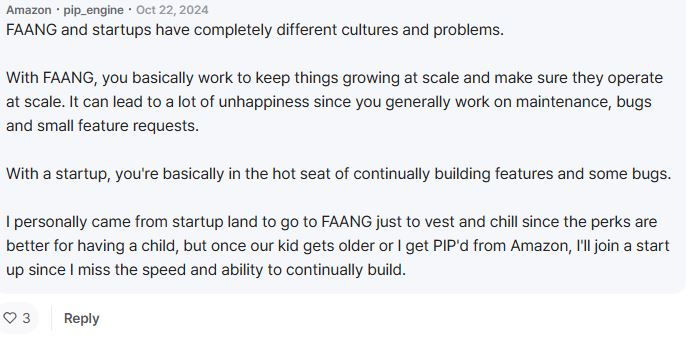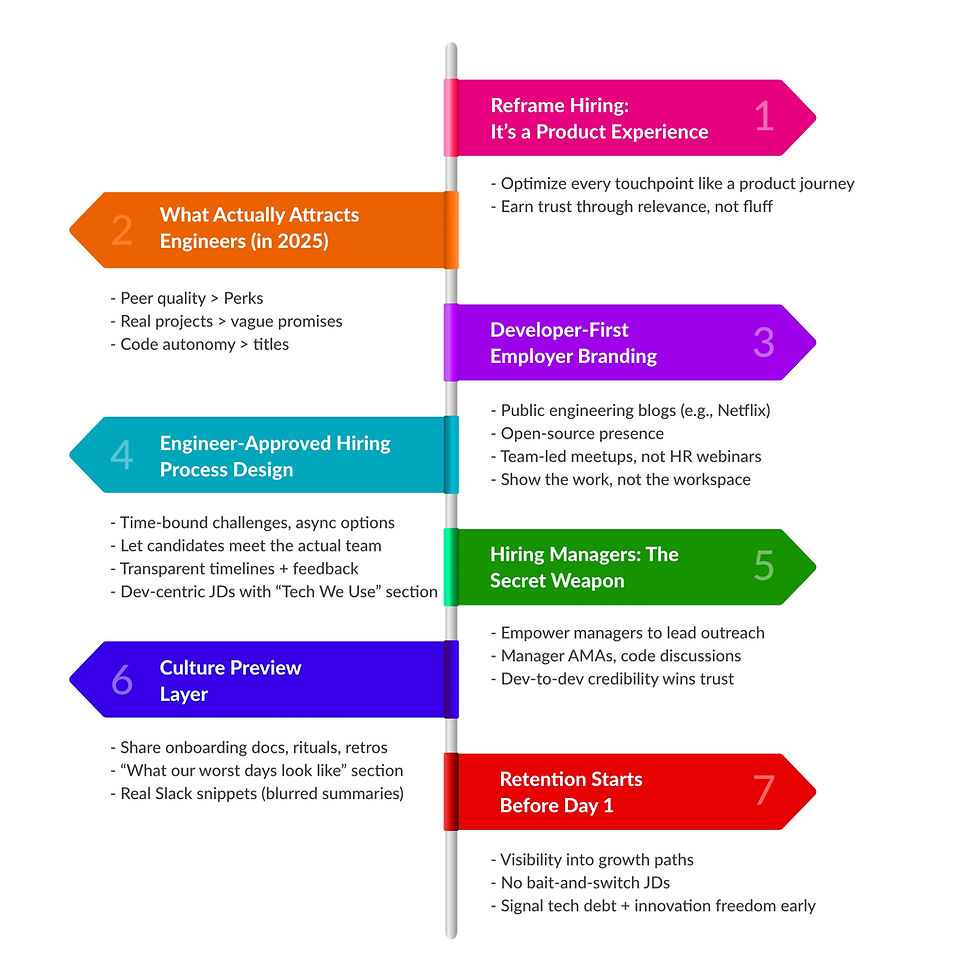Be A Tech Talent Magnet: How To Attract Top Tech Talent And Retain Them Today!
- Vaishnavee Gonnade

- Aug 5
- 10 min read

You Don’t Find Great Engineers, They Find You
Gone are the days when candidates showed up for walk-in interviews, and tech companies needed to know how to attract top tech talent and retain them, because the tech industry was booming, and everyone wanted to be a part of it.
Today, tech recruitment is far from being a walk-in process!
Organizations must treat their hiring as a product experience. Engineers evaluate the offer, but they evaluate every interaction like a UX flow.
Does this team move with clarity?
Do they respect my time?
Does this problem excite me?
If your hiring process feels like a broken prototype, top talent won't stick around to debug it.
Why and when did it happen?
Let us understand the reasons for the top talent market fatigue; yes, it’s real.
Reason | Key Statistics/Data | Impact/Explanation |
High Mobility & Churn | Reluctance to commit, constantly seeking better opportunities, high poaching risk | |
Candidate Experience/Trust | 28% of tech candidates report negative experience (60% higher vs. avg); 64% drop out due to poor communication, according to the 2024 Global CandE Benchmark Research Report | Distrust, frustration, and loss of interest in pursuing roles |
Work-Life Balance & Flexibility | 18% of roles are fully remote; 52% cite poor balance as cause of burnout (India), according to Robert Half’s Demand for Skilled Talent | Strong preference for flexible/remote work; rigids orgs lose top performers |
Mismatch with Candidate Priorities | 90% of tech workers switched jobs for growth, mentorship, and meaningful work rather than pay; legacy tech and slow innovation are top turn-offs | Companies failing to modernize/upskill struggle to attract/retain elite talent |
Tech organizations must make conscious efforts to reach the right candidates, enhance their experience, maintain a positive market image, and preserve that reputation to attract more tech talent.
What actually attracts engineers
(Hint: It’s not just money)

So, attracting top talent doesn’t have any arithmetic formula of doing a 1+1=2, nor does it apply an action-reaction law to follow a certain way, and certain results will appear.
No! It's more than what you do - it is more of WHAT THE TOP TECH TALENT PERCEIVES, what attracts them.
Let us see.
Signals they trust (Glassdoor ≠ GitHub stars)
Engineers care more about how your team works than what your careers page says. A polished culture statement or Glassdoor rating is a starting point, but what really matters is your GitHub activity, the quality of your documentation, your open-source contributions, and how your team talks about code in the wild. That’s where trust is built.
Tech stack quality
Nobody wants to join a team only to wrestle with decade-old legacy code every day. The best engineers want to solve meaningful problems using modern, scalable tools. If your tech stack is outdated, brittle, or bloated with technical debt, and you aren’t doing anything about it, they’ll see it as a red flag. You’re not just selling a role; you’re selling an engineering environment.
Peer quality >Perks
Engineers love flexibility and decent comp. But what truly attracts top talent is the caliber of the people they’ll work with. Great devs want to be around people who challenge them, push boundaries, and share knowledge. No amount of pizza parties or “fun Fridays” can beat the gravity of a smart, humble, high-performing team.
Projects over promises
Avoid the vague “we’re building something big” pitch. Top engineers are deeply motivated by what they’ll build and why it matters. Show them the complexity of your systems, the scale of your data, and the uniqueness of your product challenges. Walk them through real use cases. Make them feel the architecture, not just the ambition.
Code autonomy > job titles
Throwing around a “Senior Engineer” title doesn’t mean much if the engineer has no room to shape decisions or improve systems. Top tech talent values autonomy, freedom to experiment, influence architecture, and push code that matters. They’re looking for ownership, not hierarchy. Empowerment beats entitlement, every time.
How to build a tech-first/developer-first employer brand

Now you know what is attracting the top tech talent, you need to understand where the employer branding should head.
The tech-first approach or developer-first approach is rooted in the buyer’s journey and how you keep your customers at the forefront. In the same way, you need to think of ways that your tech team would feel a priority and be focused on.
If you wouldn’t market your product without deeply understanding your customer, why would you hire engineers without understanding what makes them choose you?
Here are a few ways you can brand yourself as a developer-first company, and
Public engineering blogs (e.g., Netflix Tech Blog, Shopify Engineering)
These aren’t SEO pieces. They’re proof of how your team thinks, solves problems, and scales systems. Engineering blogs let potential hires “meet your code before they meet your recruiter.”
What to include:
Deep dives into system design or architectural trade-offs
Learnings from incidents or rebuilds
Performance wins, DevOps pipelines, toolchain experiments
By writing publicly, your engineers become your brand. And for other engineers, that’s credibility.
Open-source presence
Nothing builds trust like transparency. Contributing to or maintaining open-source projects signals two things:
You are passionate about the tech community.
You care about the craft, not just the company.
Your engineers have autonomy and voice.
This doesn’t mean creating the next Kubernetes. Even small, useful utilities or developer tools, well-documented and maintained, go a long way.
Bonus? It creates a feedback loop where top devs engage with your repos before applying.
Tech talks & meetups by your team
Tech talent wants to see who’s behind the curtain. When your engineers speak at conferences, host meetups, or run internal tech demos in public spaces, it sends a clear message: We’re not just coding in the basement, we’re shaping the conversation.
It shows you invest in thought leadership, continuous learning, and cross-pollination. These are magnet signals, especially to senior talent.
Showcase the work, not the office
Your foosball table and kombucha bar aren’t what make an engineer hit “apply.” What does?
The scale of the systems they’ll touch
The tools they’ll get to use
The problems they’ll own
The way your team collaborates under pressure
Share snapshots of internal docs, Slack threads with some blurred names, code review styles, or sprint retros. The closer they feel to the real day-to-day, the more likely they’ll buy in.
You don’t need a big brand to attract top-tier engineers. What you do need is visibility into depth, the kind that shows your team thinks critically, builds smartly, and owns the product.
Small startups win because they:
Let engineers lead architecture decisions
Move fast without bureaucracy
Show actual product impact, not “career ladders,” but craft ladders
Engineers will choose autonomy and interesting problems over name-brand logos if they can see them.
Here are real tech people and developers talking about why a lot of them are choosing startups and small organizations.



Engineer-approved hiring process design

When hiring tech talent, that too the top ones, just knowing how to attract top tech talent is not the only thing you should know. Taking them until the last interview and closing them are the ultimate goals.
So, designing the appropriate, focused, and flexible journey for the techies is as important as attracting them.
Time-bound challenges > take-home tasks
Multi-day take-home assignments are a fast way to lose great candidates. Engineers are busy and often juggling multiple offers.
Offer tightly scoped, time-bound challenges. Ideally, something they can complete in 60 to 90 minutes. Pair it with a discussion that reveals how they think, not just what they write.
Respect their time. Show your clarity.
Let devs meet their potential team, not HR alone
If all they hear is from recruiters or hiring managers, they’ll assume your tech culture is invisible or inaccessible.
Let them talk to a peer engineer. A team lead. Even a product manager. That’s how you demonstrate alignment and transparency before the offer stage.
Transparent timelines & feedback
Vague timelines and silence between rounds are red flags. Strong candidates won’t wait around.
Be clear from the start.
How many stages?
What does each evaluate?
When will they hear back?
And offer feedback, especially if you pass. It’s rare. It earns respect.
Async interview options
Your best candidate might be in another time zone or currently employed full-time. Make it easier for them to engage.
Async tech screens, flexible slots, pre-recorded Q&A. Let them participate without jumping through hoops.
Show that you value autonomy, not just availability.
Dev-centric JD formatting
Most job descriptions read like legal disclaimers. If you want engineers to care, write like you respect their craft.
Include real tech stack details. Explain what problems they’ll solve. Show what success looks like in the role.
Make the JD an invitation, not a filter.
Hiring managers: The secret weapon
Too many hiring processes keep managers behind the scenes, while recruiters do all the talking. That’s a mistake because engineers listen to engineers.
Here’s how to put your hiring managers to work in a way that actually attracts top talent:
1.Candidates want to hear from peers and leads, not just recruiters
The message hits differently when it comes from someone who’s built the product, solved the bugs, and lived the team culture. Recruiters can open the door, but it’s the tech leads who close the deal.
3.Manager “pitch” templates for outreach and interviews
Don’t leave it to chance. Equip managers with messaging that works: why this role matters, what problems they’ll tackle, and how the team collaborates.
Templates save time, align tone, and help every hiring manager become a consistent brand ambassador.
2.Empower managers to do outreach or run code AMAs
Let hiring managers own a piece of the outreach strategy. They can share what the team is building, how they think about tech debt, or what excites them about the roadmap.
Better yet, host a monthly “Ask Me Anything” session, where candidates can drop in and ask technical questions live. No slides, no polish, just honest dev-to-dev talk.
4.Dev-to-dev trust wins
At the end of the day, engineers trust other engineers. When a hiring manager shows up early in the process, shares context, and speaks their language, it builds trust fast.
And trust is what closes offers
Designing your culture preview layer

Culture is the reflection of the team's happiness, satisfaction, which has a big impact on how well you can retain your tech talent. If your organization is able to share the first picture of it with tech candidates, it can help them understand you better.
Also, if you are able to make them a part of a sprint or so, you also get to know your tech candidate better. Here’s what you can do.
Share your onboarding docs
Your internal onboarding wiki says more about your culture than any LinkedIn post. If you're proud of how you welcome engineers, share a sample.
What tools you use, how the first 30 days look, and what to expect in week one. It signals thoughtfulness and clarity.
Let candidates peek at sprint rituals and architecture docs
Invite shortlisted candidates to shadow a sprint planning or retro. Share a lightly redacted version of your architecture overview.
This gives them context on how decisions are made, how teams collaborate, and how deep your tech stack really is.
Include a “what our worst days look like” section in interviews
Every job has friction. Be honest about what yours looks like.
Do you deal with legacy code? Tight deadlines? Async challenges?
When you share this upfront, you filter in people who are ready for the ride and filter out those who aren’t.
Use real Slack convos or retrospectives (blurred or summarized)
Take snippets of real team convos (minus sensitive details). It could be a thread where an engineer solved a production issue or a retro where people discussed trade-offs openly.
When candidates see how your team communicates, they get a real preview of daily life, not just the highlights.
This is your cultural due diligence. Don’t just say “we’re collaborative” or “we move fast”- prove it. The right people will lean in. The wrong ones will self-select out. That’s exactly the point.
Retaining the top tech talent starts before day 1

Retention isn’t something you fix after onboarding or start with onboarding. It’s baked into every signal you send during the hiring process.
If you want engineers to stay, you have to start building that trust before the offer letter is even signed.
Career growth path visibility before offer
Don’t wait for day one to talk about career ladders. Share the potential paths: senior IC track, tech lead roles, cross-functional opportunities.
Let candidates see how your org invests in growth.
Avoid “bait and switch” job descriptions
If you say “greenfield project” and hand over a legacy monolith, you’ve already lost their trust. Every top engineer has seen this before.
Write honest JDs. Clarify what’s messy, what’s in progress, and what’s next. Real talk wins.
How devs judge codebase quality and tech debt
Engineers can read between the lines. They’ll ask about test coverage, deployment frequency, refactoring time, and code review culture.
Come prepared. Better yet, show it, walk them through a recent pull request or sprint retro.
Create space for engineers to experiment (10% innovation time)
Retention thrives when there’s room to explore.
Whether it’s 10% time for side projects, internal hackathons, or funding one moonshot idea per quarter, this isn’t fluff. It’s oxygen for creative engineers.
Think of it this way: high retention starts with high alignment. The clearer you are about what the job is (and isn’t), the more likely great engineers will not just join, but stay.
Real organization, doing it right
Paytm: Winning Talent with Purpose Over Pedigree
The Challenge:
As a rising fintech in India, Paytm wasn’t flush with cash like the corporates. Competing for top-tier tech talent on salary alone was a losing game.
The Playbook:
Led with a polarizing mission — Paytm didn’t try to please everyone. Its audacious, India-scale vision became a magnet for builders who wanted to create impact, not just optimize code.
Promoted passion, not pedigrees — Instead of chasing brand-name résumés, Paytm hired hungry engineers two levels below and fast-tracked them with clear growth paths.
Digitized and narrowed the funnel — Tapped into pre-vetted tech talent pools and internal networks, making talent sourcing faster, sharper, and mission-aligned.
The Outcome:
By doubling down on vision and velocity, Paytm built a loyal, high-motivation tech team and pulled in talent who might’ve otherwise chosen the big brands. Underdog advantage: activated.

Conclusion: Attracting tech talent is a design problem
Hiring isn’t a funnel; it’s a product.
And engineers are not leads. They’re users.
Attracting top tech talent is a UX challenge: every interaction, from job post to final interview, either builds trust or breaks it.
You can’t shortcut it. You can’t hack it.
You design for it, intentionally.







